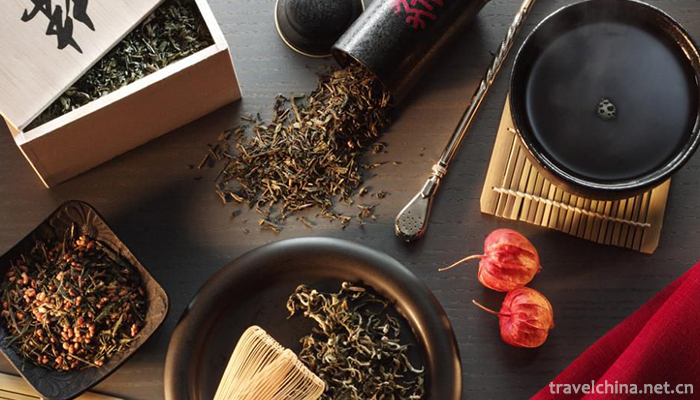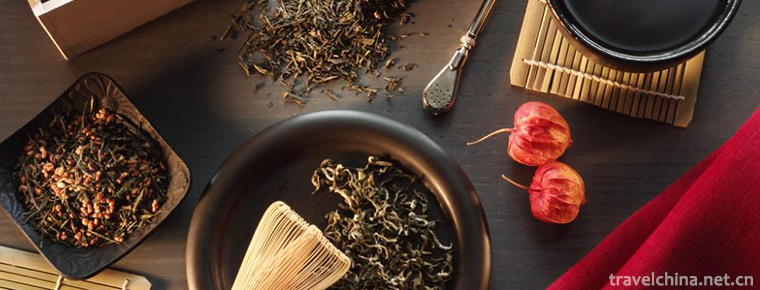Black Tea Production Techniques
Black Tea Production Techniques
Black tea, originally known as "Border Tea", was smuggled across the border by merchants as early as the end of the 16th century. In the Ming Dynasty, black tea was designated as "official tea" and sold exclusively to the northwest of Shaanxi, Gansu, Qinghai, Xin, Ning and Tibetan minority areas, so it was also called "edge (selling) tea". Black tea is one of the six major types of tea, and it is also a special kind of tea in our country. It has a long history of production, a vast production area, a large sales volume and many varieties. The output accounts for about a quarter of the total tea production in China, mainly for border sales, partly for domestic sales and a small amount for overseas Chinese sales. Historically, tea merchants trafficked Anhua black tea to Tibet, Xinjiang and other places through the ancient tea-horse road.
In 2008, black tea production technology was approved by the State Council and listed in the second batch of national intangible cultural heritage list, including the production technology of Fuqian tea in Yiyang City, the production technology of thousand-two tea in Anhua County and the production technology of South roadside tea in Ya'an City, Sichuan Province. Sichuan Ya'an Friendship Tea Co., Ltd. (Black Tea Making Techniques, South Road Tea Making Techniques) was selected as the first national demonstration base for the productive protection of intangible cultural heritage. In 2012, Gan Yuxiang was named the national representative successor of black tea production technology.
History
Xiaguantuo Pu'er tea is pressed tightly. Its concave surface looks like a small thick-walled bowl, and its convex surface looks like a small round bread. Its appearance is exquisite and its curve is exquisite. Its processing process originated from "Pu'er Tea" in Ming Dynasty and "Daughter Tea" in Qing Dynasty. It was successfully finalized by "Yongchangxiang" in Xiaguan in 1902 and has a history of more than 100 years.
Tracing back to the origin of Xiaguantuo tea can be seen from historical records. In Volume 3 of Metabolism of Zhaozhe in the Ming Dynasty, Yunnan Lue, there is a record of "all the common people used tea, steamed and duanzhi", which shows that Puer Duanzhi tea was produced at that time. Ruan Fu of the Qing Dynasty "Pu'er Tea Records" contains: "The small and nursery name of daughter tea, daughter tea is taken by women before the rain, that is, quadruple reunion tea. The Qing Dynasty's Zhang Hong's Xinyu in Western Yunnan also said, "The treasures of popular tea are the names of Maojian, Bud Tea and Daughter. Daughter tea is also a kind of bud tea, all of which are collected by women of different nationalities. The money is accumulated as makeup, so it is named. From the historical data of the Qing Dynasty, we can see the various characteristics of Daughter Tea: (1) picking time of fresh leaves (before rain); _weight (four or two weights, about 125 grams); 3) shape (group tea); 4) raw materials for making loose tea (bud tea, second only to Maojian's precious Pu'er tea); 5) the origin of the name (after the girl sells this high-grade Pu'er Tea, she accumulates private house money for purchasing the marriage at the time of marriage. Makeup. From this we can see that by the Qing Dynasty, there were more prototypes of Xiaguantuo tea processing.
The quantity of Xiaguantuo tea is similar to that of "moon cakes" group tea, which was produced by private tea shops in Jinggu County. It was sold in 1900 and made in Xiaguan, also known as "Jingguan tea". The original shape of "Yongchangxiang" Xiaguan Tea Factory has been improved. It not only absorbs the compactness and convenience of transportation of "moon cake" tea, but also fully considers the prevention of endogenous mildew caused by excessive thickness of tea, as well as the factors of post-fermentation during transportation and storage. The biggest design feature of this small bowl-shaped Xiaguantuo tea is that it can increase the surface area as much as possible in the limited space. Such exquisite design not only ensures the good air permeability of compacted tea, prevents excessive thickness of tea garden and endogenous mildew, but also increases the contact between the concave and convex surface of tea and air, effectively promotes its slow aerobic natural fermentation process, which is very beneficial to the post-fermentation of raw tea, and can make it long-term storage and lasting treasure. This classic innovative design was completed in 1902. It not only upholds the tradition, but also enlightens the future. It has a far-reaching impact on the reputation of Tuotuo Tea in Yunnan in the future at home and abroad.
The founder of Xiaguantuo Tea is Yan Zizhen (Zhengui), the head of the "four major commercial groups" in Xizhou, Dali. He established the "Yongchangxiang" business name in 1902 by joint venture with Peng Yongchang, a businessman from Jiangxi Province, and Yang Hongchun, a businessman from Beicheng City. In our country, we mainly do Yunnan and Tibet. Yunnan-Sichuan trade mainly deals with Yunnan-Myanmar and Yunnan-India trade abroad. Its business principles are: Yunnan tea sold in Sichuan and Tibet; Sichuan silk sold in Myanmar; Myanmar cotton sold in Yunnan; Yunnan Tibetan medicine sold in Sichuan. It mainly relies on long-distance trafficking and profits from the redeployment of surplus and deficiency.
Once Yongchangxiang's Xiaguantuo tea came out, it soon opened up its market in Yunnan, Sichuan, Tibet and other places. Other businessmen saw great profits in Tuotuo tea and invested in it. Xiaguan became a big battlefield for businessmen to compete for Tuotuo tea. Before the end of the Anti-Japanese War, there were eighteen tea factories in Xiaguan, including Yongchangxiang, Maoheng, Fuchunhe, Chengsheng and Hongshengxiang. In the fierce market competition, Yongchangxiang fought steadily in the business war, and made great efforts to defeat all the heroes. The "Songhe Brand" Tuotuo Tea not only attaches great importance to quality, but also has novel promotion and anti-counterfeiting methods. For example, in a certain batch of Tuotuo tea, we can find Tuotuo tea with a golden ribbon marked with a trademark. For every ten ribbons accumulated by customers, we can exchange one kilogram of tea at the distribution store.


-
1.mount fanjing
Fanjingshan: National AAAAA-level tourist attractions, National Nature reserves, China's top ten summer resorts, China's famous Maitreya Bodhisattva Dao
Time 2018-12-12 -
2.Qianling Scenic Area
Qianling Scenic Area, located in Qianxian County, Xianyang, Shaanxi Province, covers an area of 1002.71 square kilometers. Population: 580,000 (2011), postcode: 713300.
Time 2018-12-22 -
3.Bayi Memorial Hall in Nanchang
The Bayiyi Memorial Hall in Nanchang was established in 1956 and officially opened to the outside world on October 1, 1959. In 1961, it was announced by the State Council as the first batch of key nat
Time 2018-12-31 -
4.Hengshan Scenic Area
Hengshan Scenic Area, located in Nanyue District of Hengyang City, is a holy place of Quanzhen sect, the mainstream Taoist religion, with an elevation of 1300.2 meters. Because the climate conditions
Time 2019-01-16 -
5.Shangqiu Ancient Culture Tourist Area
Shangqiu Ancient Culture Tourist Area is located in Suiyang District of Shangqiu City. Based on Shangqiu Ancient City, the area of 12.6 square kilometers is covered by Guidefu City
Time 2019-02-08 -
6.Tianjin Italian Style Area
Tianjin Italian Style Area is located in Hebei District of Tianjin City. It is a quadrangular area surrounded by Wujing Road, Boai Road, Shengli Road and Jianguo Road in Hebei District. There are near
Time 2019-02-21 -
7.Bemo music
Qubila fire is well known in Meigu County, Liangshan Prefecture. He is not only a highly respected Yi Dabimo, but also a representative successor of national intangible cultural heritage projects.
Time 2019-04-04 -
8.Hexi treasure roll
Hexi Baojuan, a traditional folk literature in Liangzhou District of Wuwei City and Suzhou District of Jiuquan City, Gansu Province, is one of the national intangible cultural heritages.
Time 2019-05-03 -
9.Beach Head Wood Engraving New Year Pictures
Tantou woodcut New Year's picture is the only handmade woodcut watermarking New Year's picture in Hunan Province. It has its own style with strong local characteristics in southern Chu. Tantou Town is
Time 2019-06-18 -
10.Tin carving
Tin sculpture, the traditional Chinese sculpture art, is a unique craft in China and even in the world. It has a history of more than 300 years. The craft has a long history and has a long history. In
Time 2019-07-01 -
11.Liao Song of the Zhuang Nationality
Liao Ge of Zhuang Nationality, folk literature of Pingguo County, Guangxi Zhuang Autonomous Region, is one of the national intangible cultural heritage.
Time 2019-08-16 -
12.Deyang post and Telecommunications
By the end of 2018, the total telecom business of Deyang City has reached 12.95 billion yuan, with 701000 fixed telephone users and 3.998 million mobile phone users. The total length of optical cable at the end of the year is 138000 skin kilometers.
Time 2020-12-14